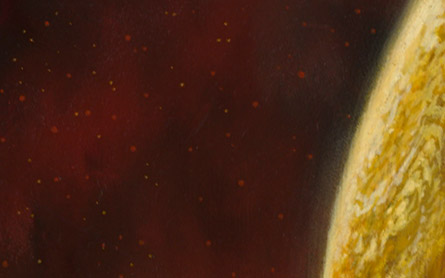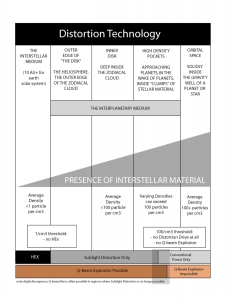How the Interstellar Medium Affects Distortion Technology

In the Iron Empires, space travel is accomplished by way of the Distortion Drive. This technology functions optimally in a vacuum, being extremely sensitive to even the smallest amount of matter in the drive’s active envelope. Thus the “terrain” of space is of crucial importance to any Hammer Lord.
 The Interstellar Medium (or ISM) is the name astronomers give to the gas and dust that pervade interstellar space. The ISM consists of an extremely dilute (by terrestrial standards) mixture of ions, atoms, molecules, larger dust grains, cosmic rays, and magnetic fields. The matter consists of about 99% gas and 1% dust by mass.
The Interstellar Medium (or ISM) is the name astronomers give to the gas and dust that pervade interstellar space. The ISM consists of an extremely dilute (by terrestrial standards) mixture of ions, atoms, molecules, larger dust grains, cosmic rays, and magnetic fields. The matter consists of about 99% gas and 1% dust by mass.
It fills interstellar space, and blends smoothly into the surrounding intergalactic medium. The ISM is usually extremely tenuous, with densities ranging from a few thousand to a few hundred million particles per cubic meter (max 200-300/cm3)), and an average value in the Milky Way Galaxy of a million particles per cubic meter (1/cm3).
The Interplanetary Medium has a somewhat higher particle density, of about 5 cm-3. The space between the planets is far from empty. It contains: electromagnetic radiation (photons); hot plasma (electrons, protons and other ions) a.k.a. the solar wind; cosmic rays; microscopic dust particles; and magnetic fields (primarily the Sun’s).
While the Sun’s radiation is obvious, the other components of the interplanetary medium were not discovered until very recently. The temperature of the interplanetary medium is about 100,000 K. Its density is about 5 particles/cm3 near the Earth and decreases by an inverse square law farther from the Sun. However, the density is highly variable, it can be as much as 100 particles/cm3. Most interplanetary matter is in the form of an ionized gas that comprises the solar wind. It consists of an almost continuous stream of particles, mostly protons and electrons, flowing out from the Sun’s corona. At Earth’s distance the wind’s density is down to about five protons and five electrons per cubic centimeter on average (10/cm3), but it can rise on occasion to 100 particles/cm3. Compare that with the number of molecules in your room, about 1019 particles/cm3.
Age: The younger a system, the “brighter” (ie more dense) it’s zodiacal cloud. Our solar system could have been 100 times more dense early in its lifespan. It will probably be less dense as the system ages. At least 2 resonant dust rings are known (for example, the Earth-resonant dust ring, although every planet in the solar system is thought to have a resonant ring with a “wake”).
(Disclaimer: these entries in my notes have been culled from across the web. I apologize to the authors for using their work without specific attribution).
If you have comments, please add them to Facebook by clicking here.




Comments are closed.